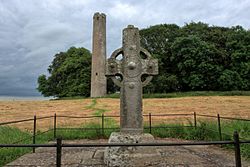Kilree
Cill Rí | |||||||||
 | |||||||||
| Monastery information | |||||||||
|---|---|---|---|---|---|---|---|---|---|
| Other names | Cell-righ Cill Ruidhehi Kell Rudi | ||||||||
| Established | 6th century | ||||||||
| Disestablished | 1539 | ||||||||
| Diocese | Ossory | ||||||||
| People | |||||||||
| Founder(s) | Rhuidche | ||||||||
| Architecture | |||||||||
| Status | ruined | ||||||||
| Heritage designation |
| ||||||||
| Style | Celtic monastic | ||||||||
| Site | |||||||||
| Location | Kilree, Kells, County Kilkenny | ||||||||
| Coordinates | 52°31′05″N 7°16′07″W / 52.518056°N 7.268611°W | ||||||||
| Visible remains | church, round tower, cross | ||||||||
| Public access | yes | ||||||||
Kilree is a former Christian monastery and National Monument located in County Kilkenny, Ireland.[1][2]
Location
Kilree is located 2.4 km (11⁄2 mile) south of Kells, County Kilkenny.[3][4]
History
The monastery at Kilree was supposedly founded in the 6th century by Saint Rhuidche, from which the name Cell-righ derives.[5]
Niall Caille, High King of Ireland, is locally believed to have drowned in the Kings River at Callan in AD 846 and his body washed up near Kells, County Kilkenny. However the Annals of the Four Masters and Annals of Inishfallen are clear the king drowned in the river Callan near Armagh.[6] Some local histories claim he was buried under the high cross at Kilree, others that he was buried outside the church grounds there because he was a pagan. The Annals however record he was heavily involved in a power struggle between two dominant monastic traditions - that of Patrick versus Brigit, with Niall favouring the latter, so the tale of his paganism is not credible. He was primarily the king of Ailech, which was in western County Londonderry, again making it unlikely he is connected with Kilree.
The site came into the possession of Kells Priory by 1340.[7] It was surrendered to Henry VIII in 1539, and he granted the abbot a life pension.[8]
Buildings
Church


This is an early church with pronounced antae, indicating that it is pre-Romanesque in date. It still retains its oval enclosure.[9][10]
Round tower

The round tower is about 26 m (85 ft) tall, depending on which ground level it is measured from. The arched sandstone doorway is 1.64 m (5 ft 5 in) above ground level and is framed by moulding. The bell-storey has four lintelled windows facing the cardinal directions. The cap is gone but battlements remain.
The tower stands on a rectangular stone pad-foundation, only found here and at Aghaviller.
High cross
Kilree High Cross was erected in the 8th/9th Century. It is 2.75 m (9 ft 0 in) tall and covered with bosses and geometric designs. The east face has a hunting scene. The west face depicts the Adoration of the Magi and Daniel in the Lions' Den.[11][12][13][14]
References
- ^ "Kilree Monastic Site".
- ^ Rees, Elizabeth (10 February 2003). Celtic Sites and Their Saints: A Guidebook. Bloomsbury Publishing. ISBN 9781441113443 – via Google Books.
- ^ Schorr, Frank. "Kilree Church".
- ^ Davenport, Fionn (1 January 2010). Ireland. Lonely Planet. ISBN 9781742203508 – via Google Books.
- ^ "Irish history podcast » Search results for "clontarf" | Irish history podcast". irishhistorypodcast.ie. Retrieved 12 September 2016.
- ^ "Annals of Inisfallen".
- ^ Past, Ed Hannon-Visions of the (23 December 2013). "Kilree Monastic Site, Kilkenny, Ireland".
- ^ Holmes, George (1 January 1801). "Sketches of ... the Southern Counties of Ireland ... 1797 ..." – via Google Books.
- ^ Schorr, Frank. "Kilree Highcross".
- ^ "Kilree Monastic Site, County Kilkenny".
- ^ "Kilree High Cross - Attractions - Churches, Abbeys and Monasteries - All Ireland - Republic of Ireland - Kilkenny - Kells - Discover Ireland".
- ^ Schorr, Frank. "Kilree Irish Round Tower".
- ^ "Kilree Monastic Site".
- ^ "The secrets of the trio of treasures at Kilree". Kilkenny People. 29 March 2012. Retrieved 12 October 2020.

